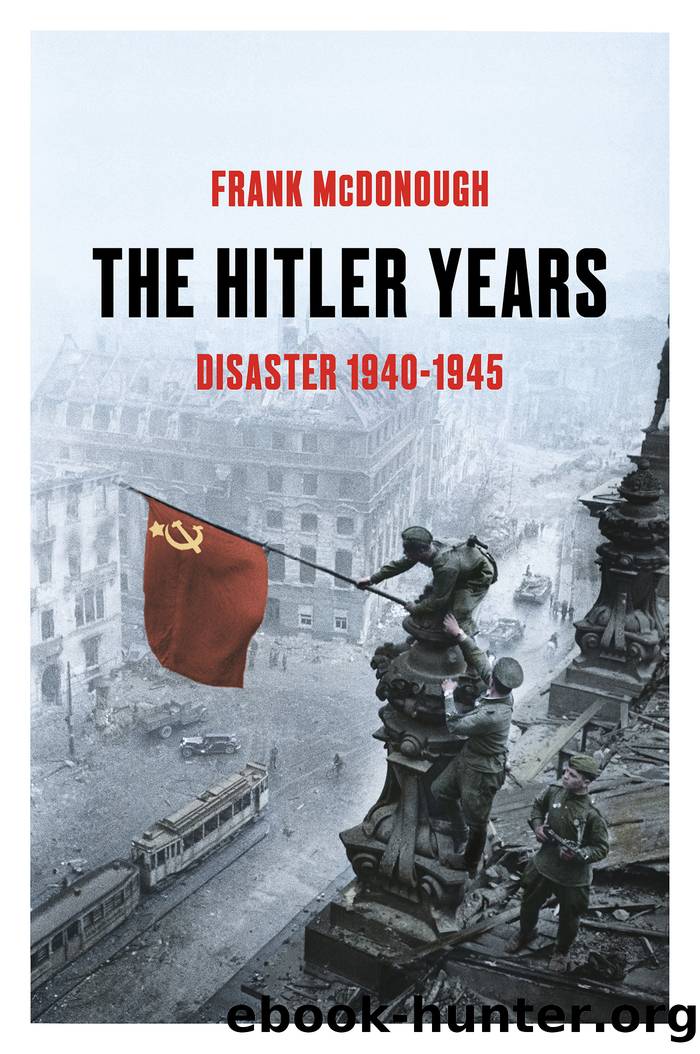The Hitler Years, Volume 2: Disaster 1940-1945 by McDonough Frank;

Author:McDonough, Frank; [McDonough, Frank]
Language: eng
Format: epub
Publisher: Head of Zeus
The tank battle at Prokhorovka on 12 July 1943.
© akg-images
Therefore, Hitler decided Operation Citadel had to be abandoned. It was time to move to a defensive posture on the Eastern Front he thought.135 Kluge, who thought the attack of the 9th Army was not progressing at all well, readily agreed with this decision. Manstein, however, disagreed, believing that his forces were poised to break through the Soviet defences. He later complained bitterly: âAnd so the last German offensive in the east ended in fiasco, even though the opposite two attacking [Red] armies⦠had suffered four times their losses in prisoners, dead and wounded.â136
Who was to blame for the failure to achieve overall victory at Kursk? Heinz Guderian didnât think it was Hitler alone as his other major generals thought. The plans for Operation Citadel were not Hitlerâs in the first place, he suggested, but the work of others, particularly Zeitzler, who had pressed Hitler to launch an offensive which the Führer had always doubted would be decisive from the beginning.137 There is absolutely no reason to suppose, as Manstein later argued in his self-justifying memoirs, that if Operation Citadel had begun in May the Kursk salient would have been captured anyway.
Unlike his generals, when Hitler cancelled Operation Citadel he was looking far more broadly at the overall German strategic position in two theatres of war: in Eastern Europe and the Allied threat to Western Europe. Manstein was still focusing narrowly on gaining Kursk, a victory which stood little chance of being decisive anyway.138 After 1945 it was commonplace for German army commanders to take all the credit for victories and to pin all the blame for military errors on Hitler, who became a convenient scapegoat for their own mistakes.139
Hitler left the Wolfâs Lair on 18 July 1943, bound for Italy. His purpose was to try and raise the spirits of his demoralized ally Mussolini. On 19 July, the two dictators held their thirteenth meeting at the picturesque Villa Gaggia, near San Fermo in northern Italy. This secluded location required Hitler to land at Treviso Airport, then travel by train and limousine to his destination. The Italian entourage included Vittorio Ambrosio and Giuseppe Bastianini, plus a retinue of other diplomats and military officials. During the three-hour meeting Hitler delivered a monologue about the importance of the current struggle for the future of Europe. He urged Mussolini to crack down on his opponents at home, then blamed the poor leadership of the Italian generals for the military disasters in Tunisia and Sicily.
Before the meeting, Mussolini was urged by his military chiefs to tell Hitler that the Axis powers needed to broker a peace settlement with the Soviet Union. Once again, however, Mussolini remained silent, much to the disgust of his key foreign policy and military advisers. In the middle of Hitlerâs bitter harangue, a messenger arrived with news that the Allies were bombing Rome. Without even stopping to express sympathy, Hitler continued to insist on Germanyâs military superiority and ultimate victory.
After Hitler
Download
This site does not store any files on its server. We only index and link to content provided by other sites. Please contact the content providers to delete copyright contents if any and email us, we'll remove relevant links or contents immediately.
What's Done in Darkness by Kayla Perrin(25499)
Shot Through the Heart: DI Grace Fisher 2 by Isabelle Grey(18218)
Shot Through the Heart by Mercy Celeste(18160)
The Fifty Shades Trilogy & Grey by E L James(17774)
The 3rd Cycle of the Betrayed Series Collection: Extremely Controversial Historical Thrillers (Betrayed Series Boxed set) by McCray Carolyn(13189)
The Subtle Art of Not Giving a F*ck by Mark Manson(12908)
Scorched Earth by Nick Kyme(11831)
Stepbrother Stories 2 - 21 Taboo Story Collection (Brother Sister Stepbrother Stepsister Taboo Pseudo Incest Family Virgin Creampie Pregnant Forced Pregnancy Breeding) by Roxi Harding(11036)
Drei Generationen auf dem Jakobsweg by Stein Pia(10216)
Suna by Ziefle Pia(10185)
Scythe by Neal Shusterman(9259)
International Relations from the Global South; Worlds of Difference; First Edition by Arlene B. Tickner & Karen Smith(8608)
Successful Proposal Strategies for Small Businesses: Using Knowledge Management ot Win Govenment, Private Sector, and International Contracts 3rd Edition by Robert Frey(8418)
This is Going to Hurt by Adam Kay(7693)
Dirty Filthy Fix: A Fixed Trilogy Novella by Laurelin Paige(6450)
He Loves Me...KNOT by RC Boldt(5804)
How to Make Love to a Negro Without Getting Tired by Dany LaFerrière(5378)
Interdimensional Brothel by F4U(5303)
Thankful For Her by Alexa Riley(5159)
